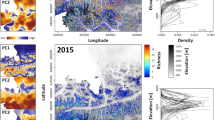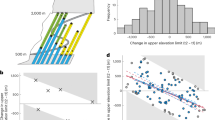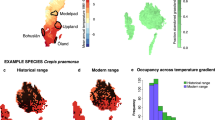Abstract
Climate impact studies have indicated ecological fingerprints of recent global warming across a wide range of habitats1,2. Although these studies have shown responses from various local case studies, a coherent large-scale account on temperature-driven changes of biotic communities has been lacking3,4. Here we use 867 vegetation samples above the treeline from 60 summit sites in all major European mountain systems to show that ongoing climate change gradually transforms mountain plant communities. We provide evidence that the more cold-adapted species decline and the more warm-adapted species increase, a process described here as thermophilization. At the scale of individual mountains this general trend may not be apparent, but at the larger, continental scale we observed a significantly higher abundance of thermophilic species in 2008, compared with 2001. Thermophilization of mountain plant communities mirrors the degree of recent warming and is more pronounced in areas where the temperature increase has been higher. In view of the projected climate change5,6 the observed transformation suggests a progressive decline of cold mountain habitats and their biota.
This is a preview of subscription content, access via your institution
Access options
Subscribe to this journal
Receive 12 print issues and online access
$209.00 per year
only $17.42 per issue
Buy this article
- Purchase on Springer Link
- Instant access to full article PDF
Prices may be subject to local taxes which are calculated during checkout



Similar content being viewed by others
References
Walther, G. R. et al. Ecological responses to recent climate change. Nature 416, 389–395 (2002).
Root, T. L. et al. Fingerprints of global warming on wild animals and plants. Nature 421, 57–60 (2003).
Tingley, M. W. & Beissinger, S. R. Detecting range shifts from historical species occurrences: New perspectives on old data. Trends Ecol. Evol. 24, 625–633 (2009).
Pereira, H. M. et al. Scenarios for global biodiversity in the 21st century. Science 330, 1496–1501 (2010).
Christensen, J. H. et al. in IPCC Climate Change 2007: The Physical Science Basis (eds Solomon, S. et al.) 847–940 (Cambridge Univ. Press, 2007).
Kjellström, E. et al. 21st century changes in the European climate: Uncertainties derived from an ensemble of regional climate model simulations. Tellus 63, 24–40 (2011).
Arndt, D. S., Baringer, M. O. & Johnson, M. R. State of the climate in 2009. Bull. Am. Meteorol. Soc. 91, S1–S224 (2010).
Parmesan, C. Ecological and evolutionary responses to recent climate change. Annu. Rev. Ecol. Evol. S. 37, 637–669 (2006).
Grabherr, G., Gottfried, M. & Pauli, H. Climate effects on mountain plants. Nature 369, 448–448 (1994).
Klanderud, K. & Birks, H. J. B. Recent increases in species richness and shifts in altitudinal distributions of Norwegian mountain plants. Holocene 13, 1–6 (2003).
Walther, G-R., Beißner, S. & Burga, C. A. Trends in upward shift of alpine plants. J. Veg. Sci. 16, 541–548 (2005).
Pauli, H. et al. Signals of range expansions and contractions of vascular plants in the high Alps: Observations (1994–2004) at the GLORIA master site Schrankogel, Tyrol, Austria. Glob. Change Biol. 13, 147–156 (2007).
Britton, A. J., Beale, C. M., Towers, W. & Hewison, R. L. Biodiversity gains and losses: Evidence for homogenisation of Scottish alpine vegetation. Biol. Conserv. 142, 1728–1739 (2009).
Gottfried, M., Pauli, H., Reiter, K. & Grabherr, G. A fine-scaled predictive model for changes in species distribution patterns of high mountain plants induced by climate warming. Divers. Distrib. 5, 241–251 (1999).
Thuiller, W. et al. Climate change threats to plant diversity in Europe. Proc. Natl Acad. Sci. USA 102, 8245–8250 (2005).
Engler, R. et al. 21st century climate change threatens mountain flora unequally across Europe. Glob. Change Biol. 17, 2330–2341 (2011).
Pauli, H. et al. The GLORIA Field Manual—Multi-Summit Approach (European Commission DG Research, EUR 21213, Office for Official Publications of the European Communities, European Commission, 2004).
Ellenberg, H. Vegetation Ecology of Central Europe (Cambridge Univ. Press, 1988).
Körner, C. The use of ‘altitude’ in ecological research. Trends Ecol. Evol. 22, 569–574 (2007).
Nagy, L. & Grabherr, G. The Biology of Alpine Habitats (Oxford Univ. Press, 2009).
Ter Braak, C. J. F. & Barendregt, L. G. Weighted averaging of species indicator values: Its efficiency in environmental calibration. Math. Biosci. 78, 57–72 (1986).
de Witte, L. C. & Stoecklin, J. Longevity of clonal plants: Why it matters and how to measure it. Ann. Bot. 106, 859–870 (2010).
Körner, C. Alpine Plant Life: Functional Plant Ecology of High Mountain Ecosystems 2nd edn (Springer, 2003).
Haylock, M. R. et al. A European daily high-resolution gridded data set of surface temperature and precipitation for 1950–2006. J. Geophys. Res. 113, D20119 (2008).
Callaway, R. M. et al. Positive interactions among alpine plants increase with stress. Nature 417, 844–848 (2002).
Väre, H., Lampinen, R., Humphries, C. & Williams, P. in Alpine Biodiversity in Europe—A Europe-Wide Assessment of Biological Richness and Change (eds Nagy, L., Grabherr, G., Körner, C. & Thompson, D. B. A.) 133–148 (Springer, 2003).
Scherrer, D. & Körner, C. Infra-red thermometry of alpine landscapes challenges climatic warming projections. Glob. Change Biol. 16, 2602–2613 (2010).
Randin, C. F. et al. Climate change and plant distribution: Local models predict high-elevation persistence. Glob. Change Biol. 15, 1557–1569 (2009).
Dirnböck, T., Essl, F. & Rabitsch, W. Disproportional risk for habitat loss of high-altitude endemic species under climate change. Glob. Change Biol. 17, 990–996 (2010).
Blanca, G., Cuento, M., Martı´nez Lirola, M. J. & Molero Mesa, J. Threatend vascular flora of Sierra Nevada (Southern Spain). Biol. Conserv. 85, 269–285 (1998).
Acknowledgements
We acknowledge the E-OBS dataset from the EU-FP6 project ENSEMBLES (http://ensembles-eu.metoffice.com) and the data providers in the ECA &D project (http://eca.knmi.nl). We thank the European Topic Centre on Biological Diversity for stimulating discussions, G-R. Walther, S. Dullinger, K. Green and T. Stuessy for internal reviewing, C. Klettner for data compilation, S. Laimer for project administration, R. Töchterle for help with Fig. 3 and approximately 80 co-workers for performing field recording. The study was financed by the European Commission, the Austrian Academy of Sciences, the University of Vienna, the MAVA foundation (Switzerland) and many other national authorities of the partner groups.
Author information
Authors and Affiliations
Contributions
G.G., H.P. and M.G. coordinated the monitoring program, performed field work and wrote the text. M.G. and H.P. conceived the study and compiled data, and M.G. and A.F. performed the statistical analyses. All other authors organized and performed field work as well as data compilation, and edited the manuscript.
Corresponding author
Ethics declarations
Competing interests
The authors declare no competing financial interests.
Supplementary information
Rights and permissions
About this article
Cite this article
Gottfried, M., Pauli, H., Futschik, A. et al. Continent-wide response of mountain vegetation to climate change. Nature Clim Change 2, 111–115 (2012). https://doi.org/10.1038/nclimate1329
Received:
Accepted:
Published:
Issue Date:
DOI: https://doi.org/10.1038/nclimate1329
This article is cited by
-
Extinction drives recent thermophilization but does not trigger homogenization in forest understorey
Nature Ecology & Evolution (2024)
-
Transnational conservation to anticipate future plant shifts in Europe
Nature Ecology & Evolution (2024)
-
Impacts of road on plant invasions in the Middle Mountain region of central Nepal
Journal of Mountain Science (2024)
-
Thermophilisation of communities differs between land plant lineages, land use types and elevation
Scientific Reports (2023)
-
Two decades of climate change alters seed longevity in an alpine herb: implications for ex situ seed conservation
Alpine Botany (2023)



